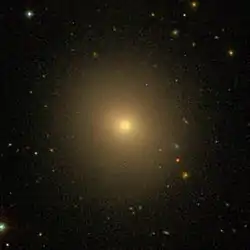NGC 636
NGC 636 is an elliptical galaxy in the Cetus constellation. It is located about 96 million light-years from the Milky Way.[3] It was discovered by the German–British astronomer William Herschel in 1785.[4][5][6]
| NGC 636 | |
|---|---|
 SDSS image of NGC 636 | |
| Observation data (J2000 epoch) | |
| Constellation | Cetus |
| Right ascension | 01h 39m 06.529s[1] |
| Declination | −07° 30′ 45.37″[1] |
| Redshift | 0.006181[2] |
| Helio radial velocity | 1847 km/s[2] |
| Distance | 95.8 Mly (29.38 Mpc)[3] |
| Apparent magnitude (B) | 12.5[2] |
| Characteristics | |
| Type | E3[4] |
| Other designations | |
| MCG-01-05-013, PGC 6110[2] | |
See also
References
- Skrutskie, M.; et al. (2006). "The Two Micron All Sky Survey (2MASS)". The Astronomical Journal. 131 (2): 1163–1183. Bibcode:2006AJ....131.1163S. doi:10.1086/498708.
- "NGC 636". SIMBAD. Centre de données astronomiques de Strasbourg. Retrieved 2020-05-19.
- Tully, R. Brent; Courtois, Hélène M.; Sorce, Jenny G. (2016). "Cosmicflows-3". The Astronomical Journal. 152 (2): 21. arXiv:1605.01765. Bibcode:2016AJ....152...50T. doi:10.3847/0004-6256/152/2/50. 50.
- "Results for object NGC 0636 (NGC 636)". NASA/IPAC Extragalactic Database. California Institute of Technology. Retrieved 2020-05-20.
- Ford, Dominic. "The galaxy NGC 636 - In-The-Sky.org". in-the-sky.org. Retrieved 2020-04-07.
- "Revised NGC Data for NGC 636". spider.seds.org. Retrieved 2020-04-07.
This article is issued from Wikipedia. The text is licensed under Creative Commons - Attribution - Sharealike. Additional terms may apply for the media files.